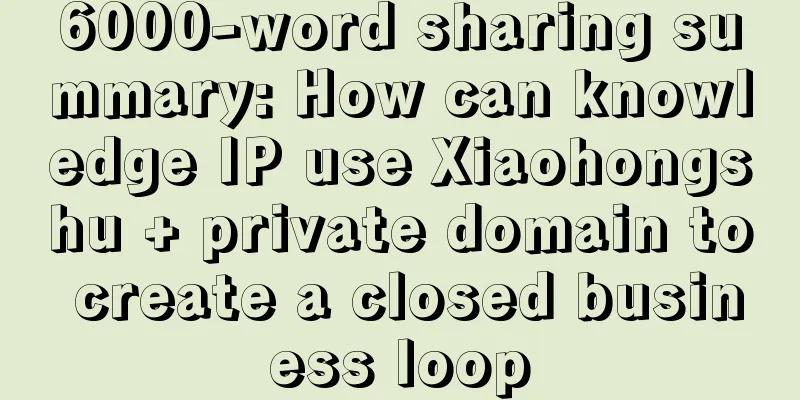6000-word sharing summary: How can knowledge IP use Xiaohongshu + private domain to create a closed business loop

Many of my friends are planning to build their own IP in the new year, especially for professionals with certain technical barriers, such as doctors and lawyers. However, before doing it, you should think about one question: What is the purpose of our IP? I think this question is not redundant, and it will be much smoother if you think it through. The next step is to design a monetization product and decide what we want to sell. 1. Create exclusive knowledge monetization productsAs for knowledge IP, most products are actually paid knowledge. For the common knowledge products on the market, I think they can be roughly classified from the following aspects: First, the product serves the goal. So for knowledge bloggers , from the perspective of product delivery goals , they can choose to create the following categories:
Generally speaking, if someone has IPs of four products at the same time, he or she can be preliminarily identified as a top KOL. Next, we can consider the following aspects from the perspective of the user's sense of achievement and the form of deliverables : 1. Valuable content/knowledge Delivery format: *** classes, *** cases, *** live broadcasts by big names, etc. 2. Capacity improvement/visible results Delivery form: ***Assignment guidance, ***Certificate, ***Portfolio, ***Work/practical opportunity 3. High-quality social relationships/circles Delivery form: online/offline linking activities, such as providing *** opportunities/resources, matching upstream and downstream resource cooperation 4. Unique and rare experience/service Delivery form: group meditation, test report interpretation, etc. Inspired by teacher Liang Ning’s offline get out of class, I would like to provide you with a value formula tool that you can use before you plan your product. Take the circle product I made as an example. No product is suitable for everyone, so we can only satisfy the people we can satisfy, and don't think about meeting everyone's needs. After choosing the right people, carefully perceive their needs and think about what the product means to them. Finally, refine your product value and features. I believe that after sorting out, you can at least make your product ideas clearer and the direction you want to work towards. Let me extend this a little bit. A friend on my planet asked a question a while ago. I think it is quite representative and also a little tip for everyone. For many newbies who have no fans in the early stage and are starting from scratch, they may encounter two small problems in the process of becoming a knowledge blogger:
These two problems are relatively common, and I have encountered them myself. First of all, I think positioning is the premise of everything, whether you are building an account or making a set of courses. You should have heard a lot about the positioning methodology. In short, it should be to answer a few questions clearly:
What you like will last longer; what you are good at will help you survive; the achievements you make will make strangers have initial trust in you; and referring to your competitors will help you avoid detours. Secondly, there is the issue of external charging. For example, my personal suggestion to the partner above is: if you want to use Knowledge Planet as your subsequent monetization product, try not to make it free. You can try to start with a low price and set a payment threshold, such as 19.9 yuan, so that your target users can feel and take action, so that they can remember you. This is also a way to screen paying users and eliminate those wool parties. 2. Knowledge IP leverages Xiaohongshu to efficiently attract trafficIn addition to the previous two questions, there is actually another very important question, as mentioned by the partner above: How to attract traffic and exposure more efficiently after having your own product? In addition to internal growth based on social networking (such as fission activities/referrals, etc.), we need to rely more on external growth driven by public domain platforms, which is also the most cost-effective and efficient way. Let's talk about the Xiaohongshu platform. First of all, it should be pointed out that it is officially prohibited to divert traffic from Xiaohongshu to other platforms. All methods are time-sensitive and uncertain, and the actual diversion effect is not guaranteed. To put it bluntly, diverting traffic from platforms is playing a game with the platform's review mechanism. I generally recommend diverting traffic after you have 1,000+ followers and have certified professional accounts. Here I will introduce several common and my own frequently used ways to attract traffic to Xiaohongshu. Method 1: Account basic configuration diversionGenerally, traffic can be directed through Xiaohongshu account, avatar, and personal profile. A. Xiaohongshu account Each Xiaohongshu account can only be set up once. When a user asks how to contact you, or wants to add your WeChat, you can directly reply with the following words, which are generally understood. The following is my Xiaohongshu account ID, which is set to my own WeChat account. Reference words: You can look at my Xiaohongshu ID/next to my avatar/look at the Xiaohongshu ID under my name... B. Personal profile There are many things you can do here. For example, you can set up a special account (the first article on the account can be pinned to the top), set up an email address (set up an automatic reply to the email address), and divert traffic to other platforms. Like my small account traffic notes, I usually throw all my products and services on it. Don't worry about the flow limit problem for small account traffic notes, as long as it can be displayed on the small account. Our goal is to attract traffic through the big account to the small account and play a coordinated battle. C. Avatar traffic diversion This method is actually very easy to understand. It is to watermark the WeChat ID on the avatar, but I don’t recommend this method because it is an overt way to divert traffic, which can easily be reported by peers and penalized by the platform. Method 2: Use trumpet to attract trafficWe mentioned earlier that you can tag your secondary account in the basic account configuration. In fact, there are other ways to play. For example, my current method of attracting traffic is to collect the secondary account's traffic notes, and then guide all the partners who come to consult to "see my collection notes". In addition, you can also use the secondary account to answer users' questions in the comment area and guide potential customers to send private messages to the secondary account. In this way, others can see your series of products and services when they open your secondary account homepage, and they will naturally add it to the private domain if they are interested. Method 3: Use small group chat to attract trafficEach person can create 5 groups on Xiaohongshu, and the used group quota will be released after exiting. Compared with private messages, group chat is safer. And another big advantage of entering the group chat is that you can set it to follow your Xiaohongshu before joining the group. In this way, you can also increase your fans and reach them multiple times. At present, my fan joining rate can reach 34%, and then I will post my latest notes in the group, and use the small account to send some drainage information. Method 4: Private message traffic from XiaohongshuLast May, the platform imposed more restrictions on private messages: [Important notice on the number of stranger messages! ] The new rules are as follows:
Compared with the past, the number of people actively sending private messages has not actually decreased, but the number of messages sent to strangers has been greatly limited. In the past, you could send 3 messages to strangers, but now you can only send 1. In addition, there are some pitfalls to be aware of when sending private messages on Xiaohongshu:
Method 5: Enterprise account traffic diversionEnterprise accounts are the only official way to establish links with users. You can send private messages to enterprise accounts with contact information and off-site information without restrictions, and you can conduct normal traffic diversion. In addition, a big advantage of enterprise accounts is that they support binding addresses and phone numbers. If you have a store, you can directly guide customers to the store. In addition to the above, there are actually some very wonderful ways to attract traffic, such as "attracting traffic through instant check-ins", but now the control of such platforms is becoming more and more strict, it is difficult to pass, and the risks are also relatively high, so it is not recommended. 3. 6 steps to build private domain content marketing processNext, let's talk about how to convert the users that you have worked so hard to attract into your private domain. If you want new friends to have initial trust in you, you need to package your WeChat account well.
After passing the test, we need to reach and influence users through a series of content and finally close the deal. Our private domain content can be roughly divided into "push content" and "pull content" according to the form of content marketing. The so-called "push content" is easy to understand. It focuses marketing on promoting its products, such as many WeChat business circle of friends advertisements, product descriptions, etc. The other is "pull content", which creates consumer demand for the product and generates demand pressure. It generally starts from the practical perspective of solving the problem and provides potential consumers with practical solutions. As a general knowledge IP, it should continuously output pull-type content based on trust. Based on this consensus, let’s see how private domain content marketing should proceed. Step 1: Understand user portraits and do user stratificationOne of the pitfalls we encountered in the early stage was that we did not have a clear understanding of the boss group, and we still based our operation ideas on the common mother group. As a result, we spent a lot of time on group activation and ignored the necessity of 1V1 private chat. You should know that the boss group is relatively special. Most of them are very busy and rarely have time to patiently read group messages. This is why for many companies whose main users are business owners, telemarketing + meeting sales have always been the main effective promotion methods. If the focus is wrong, it will only be half the result with twice the effort. Sometimes it is not necessarily the marketing content that makes people disgusted, but the lack of understanding of the user's real needs and the wrong communication methods. User portraits are generally classified into user attribute tags, demand tags, behavior tags, and intention tags. Attributes and needs are static information, which can be obtained from third-party platforms or by conducting direct research around existing customer groups. Behavior tags and intention tags are generally obtained through design questions and user behavior during the operation process. We push different content to different groups of people with different preferences. For example, for a doctor IP focusing on postpartum health, some users want to learn about postpartum depression, while others are interested in nutritional matching. We may also divide the content into different stages of postpartum. Customized content is very effective for us to serve high-net-worth individuals. Step 2: Sort out user behavior pathsChen Yong, the author of Super Conversion Rate, once said: "Only when the granularity is refined to every step of the process control can success be replicated." The same is true for the flow of user paths. No matter how things change, they remain essentially the same. You can sort them out according to the AARRR classic model (acquisition-activation-retention-conversion-propagation). You can generate some corresponding operational actions for each link. This idea can also be embodied as a user journey map, mapping a specific process/link in the user's private domain experience, and their possible behaviors, feelings, and thoughts. Step 3: Determine what to post in the private domain and how to post itFrom the user's psychological activity path above: stimulate interest - build trust - place an order immediately. At different stages, adapting appropriate content and breaking through the user's psychological defenses can improve the final conversion rate. For example, in the stage of stimulating interest, you can focus on outputting content in the following directions:
For example, in the stage of building trust/immediately placing an order, you can focus on the following content:
The above only gives a general direction. As for what specific content we want to post in social groups, Moments, and private chats, we have to think about the issue of topic selection, which is essentially the same as choosing a topic for writing an article. There are roughly two ways to find topics: objective + subjective Objective level - a. Competitive product research Conduct preliminary analysis through the data of similar competing products, target topics with high sales and popularity, and plan similar topics b. User research First, preliminarily determine a topic direction (it may also be proposed by users), then gradually subdivide it, make it into a survey questionnaire and send it to the fan group, or find a third-party platform to assist in market research c. Combine "Baidu Index + WeChat Index + 5118" to determine the popularity of keywords , for example: Baidu Index, WeChat Index, 5118, etc. Subjective level - Below is a table that I used to select topics for private domain content in the early stage. It can be adjusted according to the specific business. Of course, you can also consider using mind maps to explore topics. After deciding on the topic, you have to consider the form of the content. In addition to the rough graphics, texts, videos or live broadcasts, there are actually various ways to express the content: case analysis, evaluation videos, unboxing videos, UGC (user-generated content) communities, comic strips, Q&A, etc. To give a simple example, in the early stages of the project, I came into contact with many mothers of newborns. After in-depth communication with several mothers in the member group, I found that they all had a strong demand, which was to “ask a doctor.” Mothers not only care about the professionalism of the content, but also care about whether the doctor is in the group/whether there is an opportunity for 1v1 communication, and whether the current parenting problems can be solved in time. Based on this, our operation strategy tends to output "question-and-answer content" or create more opportunities for interactive question-and-answering. Step 4: Determine content distribution channelsIn the private domain, the most universal and core ones are group chat, private chat, and Moments. Let's briefly talk about them respectively:
Different forms of touchpoints can have different effects on users. Select your core touchpoints, or combine 2-3 touchpoints for testing, such as "live broadcast + community" or "community + personal account + circle of friends". Step 5: Develop executable SOPsAfter preparing the above strategies, SOP is almost ready. In simple terms, it is to solve the problem of 5w1h.
Step 6: Content optimization based on subjective and objective feedbackThe iteration of SOP usually goes through the complete chain from internal testing to large-scale replication. So, what is the basis for the iterative optimization of SOP? The dimensions I think about are generally from two perspectives: subjective and objective. First of all, we say that at the objective level, we generally focus on two types of data: process data and result data. The result data must be strongly related to the goal we set initially, that is, whether you want to increase the number of new users or total revenue, or hope to achieve an ideal conversion rate model. The worst thing is to have both. Process data is actually closely related to the third step of "sorting out user paths" mentioned above, that is, a series of phased data that may be generated based on the user behavior path touchpoints. If it is an online low-to-high-level training camp, from preparation-camp opening-learning-camp closing, the general process data will involve: group entry rate, camp attendance rate, learning check-in rate, homework submission rate, daily interaction rate, etc. The result data may involve: the number of students converted to regular courses and total revenue. If the result data is not ideal and the process data is also bad, then the SOP strategy needs to be re-formulated; at the same time, it can also be seen which specific link still has room for optimization. Secondly, at the subjective level, understand the user's subjective feelings in the entire SOP chain. This can be done by combining questionnaire surveys with user interviews. User experience can be measured using the NPS tool, and NPS (Net Promoter Score) can be used to provide feedback on user loyalty. NPS score = (number of recommenders - number of detractors) / total sample size An NPS score of 50% or above is considered to be basically qualified. If the NPS score is between 70% and 80%, it indicates that the proportion of highly loyal customers is very high. I hope the above can give you some inspiration. Author: Aning Running; Official Account: Fine Operation Aning (id: choose0001) |
<<: Is it easy to get Spring Festival red envelopes from various Internet platforms this year?
>>: Live e-commerce in 2022: End and rebirth
Recommend
How to change the password of Shopee store? What functions does the function bar have?
Some of the merchants engaged in cross-border e-co...
How much does THC cost? Introduction to the cost standards
We do cross-border business. If we want to transpo...
Do we really understand older consumers?
The market is generally optimistic about the silve...
Do Amazon China stores need to pay taxes? What taxes should be paid?
Whether you want to open a store on Taobao or do c...
How to fill in the Wish store? What information is required to open a Wish store?
Wish is a world-renowned e-commerce platform that ...
How long does it take for a new Amazon seller to ship goods? How to ship goods on Amazon?
A key issue for new sellers is their shipping time...
How long will it take to get your money back if you spend 400 yuan on cigarette box recycling?
Do you know about cigarette box recycling? Startin...
Internet celebrity soda, pour it before the hot summer comes
Exploring the rise and fall of the internet-famous...
Rebirth: New opportunities for small and medium-sized businesses on Xiaohongshu
This article analyzes the marketing cases of Xiaoh...
The rise of KOS matrix! 7000 words to explain how to move from public domain to private domain
Last year, when Xiaohongshu promoted buyer culture...
Internet giants are starting to grab new turf
During the Spring Festival holiday, the short play...
The first Chinese luxury brand to succeed overseas may be a confinement center
Through precise insights and high-quality content,...
With 5 listed companies, business legend Liu Qiangdong has 20 classic quotes that are worth reading!
JD.com boss Liu Qiangdong wrote 20 classic quotes ...
Pinduoduo new product launch process
This article starts from the author's experien...
Share some basic marketing concepts and important marketing theories
Marketing seems simple but it is not simple at all...









